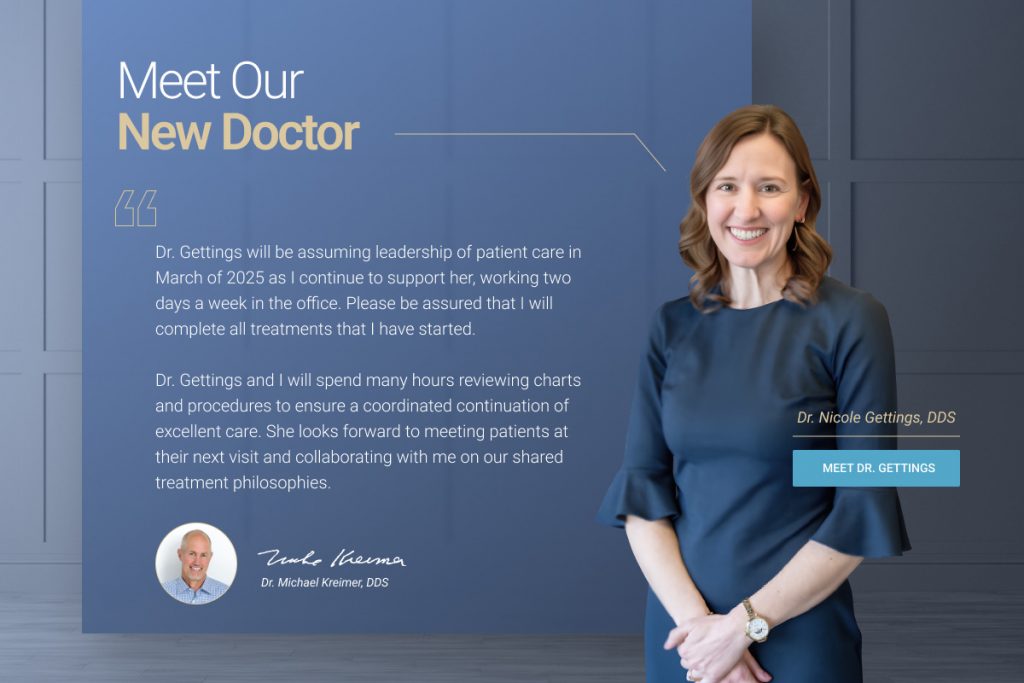When Teeth Need to Come Out
Is your tooth infected or causing you pain? You may need a tooth extraction to save your oral health. While intimidating, tooth extractions are a common procedure in dental care to help save your oral health. At our Loveland, OH, dental office, our dentist, Dr. Michael Kreimer, strives to make extractions as smooth and comfortable for patients as possible. This article provides an overview of why extractions occur, what the process entails, and tips for proper recovery.

What Are Tooth Extractions?
Tooth extraction is a type of oral surgery that involves the surgical removal of a tooth from its socket in the bone. This procedure is sometimes necessary when a tooth’s too damaged or diseased to be repaired with fillings or crowns.
While losing a tooth may seem daunting, patients can rest assured that today’s extraction techniques are safe and effective, and aim to preserve as much bone structure as possible.
Reasons for Tooth Extractions
Tooth extractions are performed when a tooth is too diseased or damaged to remain in the mouth. Common reasons include:
- Severe Tooth Decay or Infection — This occurs when the decay is too deep and has damaged the pulp or nerve of the tooth. Root canal therapy may not be enough to save the tooth.
- Fractured Teeth — Cracks or trauma that split the tooth extensively often require extraction if the pieces can’t be saved.
- Orthodontic Treatment — Teeth are sometimes extracted to allow proper alignment and straightening with braces.
- Overcrowding — Insufficient space can cause crooked, overlapping teeth, and the removal of one or more teeth provides room.
- Impacted Wisdom Teeth — These become trapped under gum tissue or bone and can cause pain or lead to infection if not removed.
- Preparation for Dentures or Dental Implants — We may need to extract existing teeth for the placement of partial, or full dentures, or dental implants.
Types of Tooth Extractions
There are several types of extractions Dr. Kreimer may perform depending on the positioning of the tooth and the health of the surrounding bone and tissues. The main types of extractions are:
Simple Extraction
A simple extraction is when the tooth is visible in the mouth, fully erupted through the gums, and has enough structure for the dentist to grip with instruments to remove it.
Surgical Extraction
Surgical extraction is required for impacted or unerupted teeth, as the dentist needs full access to bone and gum tissue to extract it. Surgical extractions are often done for wisdom teeth.
Complex Extraction
A complex extraction is when significant bone removal or sectioning of the tooth is needed if the tooth has curved roots, is ankylosed (fused to bone), or is fractured below the gum line.
Soft Tissue Impaction
A soft tissue impaction is when the tooth is covered by gum tissue, which must be opened to access the tooth. Local anesthetics and sutures are needed.
Partial Bony Impaction
A partial bony impaction is when part of the tooth protrudes through gum and bone must be removed around the tooth to extract it.
Full Bony Impaction
A full bony impaction is when the tooth is completely encased in bone, which must be drilled away. This is most common with wisdom teeth.
The Tooth Extraction Procedure
Extractions are performed in our dentist’s office, using a numbing local anesthetic to ensure the patient’s comfort. Here’s an overview of the process:
- Our Loveland dentist will administer a local anesthetic near the extraction site to numb the area. He can also provide you with sedation dentistry to make your procedure easier.
- Once fully numb and comfortable, Dr. Kreimer will use dental tools called elevators to loosen the tooth and surrounding gum tissue from the bone socket.
- The tooth is then extracted using forceps that gently rock the tooth back and forth carefully until it’s completely out of the socket.
- For impacted wisdom teeth or firmly rooted teeth, a small incision into the gum tissue may be needed with some bone removal to access and extract the tooth.
- After extracting the tooth, he’ll place a gauze at the site and have the patient bite down firmly to encourage a blood clot to form and stop the bleeding.
- He may place one or two dissolvable sutures to close the gum tissue over the extraction socket.
Recovery Time and Aftercare
Proper aftercare following a tooth extraction is vital to reducing complications and speeding healing. Patients can expect:
- Recovery time of one to two weeks for minor extraction sites to fully heal. Deeper extractions may take longer.
- Mild to moderate pain and swelling for several days that can be well managed with over-the-counter pain relievers.
- Antibiotics may be prescribed if infection is a concern.
- Some oozing of blood for the first 24 hours. Changing gauze pads as needed will help.
- Avoid drinking with straws, smoking, or swishing vigorously since it can disturb the clot.
- Avoid hard, crunchy foods and stick to soft foods for the first few days.
- Follow any other recovery guidelines provided by your dentist. Promptly call the office with any concerns.
Frequently Asked Questions
How long does a tooth extraction take?
A simple tooth extraction usually takes 30-60 minutes. However, surgical extractions can take over an hour to complete. The length of time depends on the positioning of the tooth and the complexity of the procedure needed to remove it.
Should I have someone drive me home after?
Yes, you should arrange for transportation after having a tooth extracted. The numbing medication and any sedatives prescribed can make you drowsy and unable to drive safely following the procedure.
When can I resume normal activity after an extraction?
After a tooth extraction, you’ll need around one to two days of rest before returning to normal activity. Additionally, avoid strenuous exercise for at least three to four days after the extraction, as it can disturb healing.
How soon after an extraction can I get a replacement tooth?
Following an extraction, dental implants require a healing period of six to 12 weeks before the implant placement procedure. However, bridges or dentures can often be placed as soon as the extraction site has fully healed, which takes approximately four to six weeks.
Is a Tooth Extraction Right for You?
Our Loveland dentist and skilled staff are dedicated to making your extraction procedure as gentle and painless as possible. If you require a tooth extraction, call our Loveland office at (513) 677-3656 to schedule a consultation with our Loveland dentist to determine if you’re a candidate for a tooth extraction. We proudly provide services to new and returning patients in Cincinnati and surrounding areas like Murdock, Landen, Mason, and Reading, OH.


